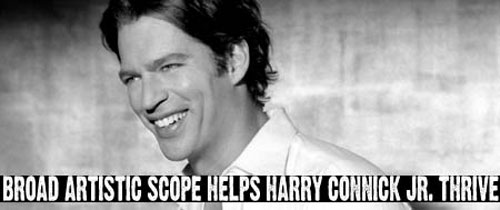Broad Artistic Scope Helps Harry Connick Jr. Thrive

Ever since his 1989 breakthrough album When Harry Met Sally , Harry Connick, Jr. has willfully swum against the prevailing musical tides. Impervious to pop trendiness, the New Orleans native remains a one-man entertainment juggernaut — a singer, pianist, composer, arranger and actor whose boyish appeal is offset by an unrelenting ambition.
Now, with the release of his new CD, Connick triumphantly returns to the impressionistic big band approach that thrust him to stardom. Employing the same strategy that made When Harry Met Sally a crossover hit, Only You features Connick giving the torch treatment to ’50s and ’60s pop nuggets like Stevie Wonder’s “For Once in My Life,” The Drifters’ “Save the Last Dance For Me” and Fats Domino’s “My Blue Heaven.” Rounding out this languid collection is “Other Hours,” a Connick original that more than holds its own among the featured classics.
Fans welcomed Only You like manna from heaven, as the disc rocketed into the Top 20 soon after its release. And thanks to a new DVD video entitled Only You In Concert, Connick fans can view their hero performing his new songs from the comfort of their homes.
It seems only fitting that Connick would resuscitate America’s elegant, post-Depression sounds. Like Frank Sinatra and the big band icons of yore, Connick is a rakish renaissance man with a vaudevillian soul. Though best known for his vintage pop recordings, he is also an acclaimed jazz pianist whose off-kilter style has earned favorable comparisons to Thelonious Monk.
Given the platinum success of When Harry Met Sally , some critics predicted Connick would make a career of milking the big band cash cow. But during the ’90s, the multi-talented singer threw curve after curve, revealing his fearlessness, musical curiosity and broad artistic scope. His albums ranged from original instrumental and vocal recordings (“Lofty’s Roach Soufflé,” “We Are in Love,” respectively), to rumpshaking funk excursions (“She,” “Star Turtle”) and starry-eyed balladry (“To See You”). As the ’90s morphed into a new millennium, Connick combined all his influences on his decade-ending magnum opus, Come by Me .
Recent years have seen additional triumphs, including his Grammy-winning Songs I Heard, and a recent jazz quartet collection, Other Hours . The latter disc is the first of a Connick on Piano series to be released by Marsalis Music. It contains instrumental versions of the Tony Award-nominated songs Connick composed for the Broadway musical Thou Shalt Not .
All told, Connick has sold over 20 million records worldwide and won three Grammy Awards, an undeniable testament to his musicianship and creative integrity.
But music only partly explains Connick’s appeal. Like his “Rat Pack” forebears, Connick has also exerted a considerable influence on the worlds of television and feature film. His Hollywood credits include Memphis Belle, Hope Floats and Independence Day , while his TV appearances include the ABC production of South Pacific and a recurring role on the NBC hit series, Will & Grace .
Add to these achievements nominations for Tony Awards, Emmy, Oscar, Golden Globe and Cable Ace Awards, and you get a clearer sense of Connick’s drive.
Born and raised in New Orleans, Connick studied piano with jazz legends Ellis Marsalis and James Booker. Commencing his career at age 5, he cut his first jazz album at 10. At the still-tender age of 18, he moved to New York and recorded his self-titled Columbia Records debut. On his sophomore effort, 20 , Connick introduced the smoky jazz arrangements and lilting vocals that would become his trademark, an approach he refined on his multi-platinum disc, When Harry Met Sally .
Connick once again applied his formidable skills during a series of 2003 sessions at Hollywood’s legendary Capitol Studios. The result was not one, but two CDs — Only You and the Christmas-time collection, Harry for the Holidays . Recording on the piano once played by Nat “King” Cole, Connick guided the members of his working big band — augmented in some instances by a full string orchestra — through two different programs.
“It’s all music, and a matter of subtly switching gears,” Connick said, explaining the challenge of recording two distinctly different CDs.






Community
Connect with BMI & Professional Songwriters